How to spot fascinating fungi this autumn
National Trust
Partner organisation of the Watches
At this time of year, many people spend their autumn walks looking up to marvel at the rich colours of our trees. But take a closer look at what’s growing under your feet, and you’ll be treated to an equally dazzling spectrum. From bright red waxcaps to small, purple corals, fungi in woods and grasslands come to life at this time of year, especially after periods of heavy rainfall. Grassland fungi are full of surprises – with names like the powdercap strangler, splendid waxcap or deceptive earthtongue.
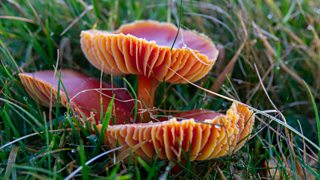
Scarlet waxcap is a typical grassland species. (c) National Trust/Victoria Holland
A forgotten kingdom
Fungi live for hundreds of years underground - the ‘mushrooms’ we see on the surface are known as fruiting bodies, like apples on a tree, and they’re just one part of the organism. They don’t fruit every year, so you may see fungi in one field this year, but never see it again in your lifetime.
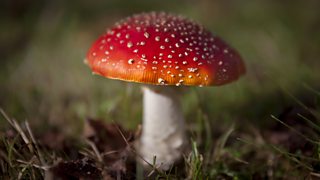
The fairytale fly agaric (c) National Trust Images/John Millar
These spectacular life forms exist in a delicate balance with the ecosystem around them. They recycle nutrients and help trap carbon underground too. Some fungi can help us understand how old a field is; just like ancient woodlands, there are also ancient grasslands.
Grassland Fungi Officer for the National Trust, Steve Hindle, says that rain makes ideal growing conditions: “There probably aren’t many people that look forward to the autumn rain like I do. A little bit of rain is all it takes to get the grassland fungi fruiting. Not only do these fungi look stunning with a huge variety of colours and forms, they also create incredible networks beneath the soil. They mine minerals from the ground and then exchange this with plants for carbon. These fungi can then live for hundreds of years, holding that carbon within the soil.”

People looking at bracket fungi on a tree (c) National Trust Images/Rob Coleman
“Fungi exist in a very fine balance with the plants around them, but that balance can easily be thrown out through human intervention, like ploughing or using fertilisers.
“Unfortunately, the landscapes where they thrive are declining, but you can still see grassland fungi in upland areas, usually in grazed pasture or hay meadows. These incredible species are not as well studied as other lifeforms, so we still have lots to learn about how important they are.”
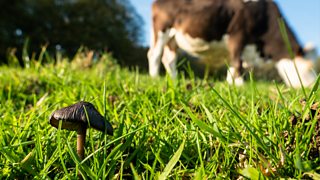
Fungi, like this Pink Gill mushroom, can be found in fields grazed by cows 漏 National Trust images/Rob Coleman
Where to go
October and November are the perfect months to look for fungi, especially if there’s been plenty of rainfall. In woodlands, look on the floor among the leaf litter, on tree trunks or on fallen trees, where fungi thrive. This is where you might see bracket fungi, which grow in layers up trees. You may spot the iconic fly agaric - the red toadstool with white spots which grows on the woodland floor.
In fields, look for places where cows and sheep graze. Steep or hilly sites with short grass are usually the best for spotting species like waxcaps. The mushrooms, or fruiting bodies, can pop up almost anywhere (although you will spot plenty of fungi that like to grow near or in dung.)
Waxcap wonders
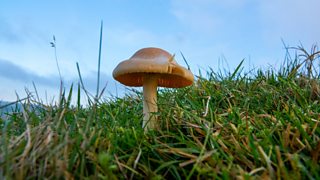
Meadow waxcap is an indicator of ancient grasslands (c) National Trust/Victoria Holland
The meadow waxcap is one of the clearest indicators of ancient grasslands. It starts off small, with a thick cream stem and an apricot-coloured cap. It often grows to a large size in rings or groups and can last for a few weeks - so it’s a great one to look out for.
Tucked amongst the grass, you may also spot corals, clubs or spindles. These forms of fungi look like little branches growing from the ground, and can be purple, yellow or cream.
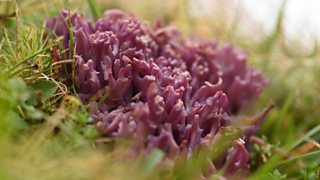
Purple spindles are another species to look out for (c) National Trust Images/John Malley
Don’t pick or eat fungi, as there are so many species it’s easy to pick ones which might not agree with you or even be poisonous. Instead, enjoy their beauty, take photos and leave them for the next person out on their autumn walk to enjoy.
